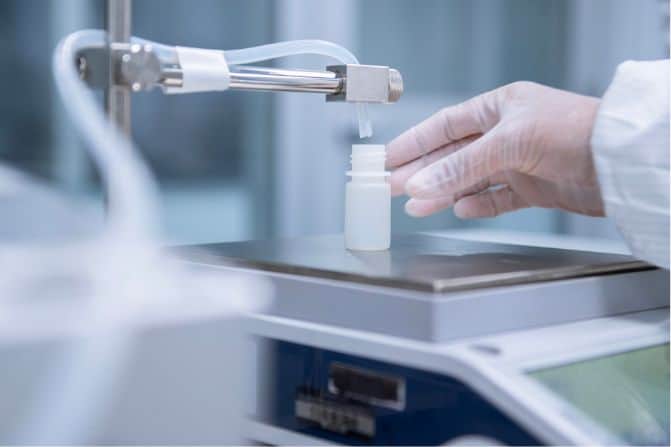Questions asked when planning Life Science Manufacturing Automation and Scale-up
In life science manufacturing automation and scale-up is challenging. When picturing a manufacturing line, you likely conjure up images of automated multi-function equipment or deft robotic arms. However, for the vast majority of life science companies, the reality is quite different. Bound by small scales and complex products, most life science products begin with a manual manufacturing process. At Argonaut, we are frequently asked about automation by our clients:
- How can I scale-up my project?
- Can my project be automated?
- When does it make sense to implement automation?
- How do I make the transition?
Manufacturing process scale-up is a challenge that most companies eventually face. Use this guide to determine if and when automation is the right solution for your life science manufacturing project.
In life science manufacturing automation and scale-up is challenging.
Why and when to automate
With rare exception, life science manufacturing projects start out producing at small scales. Lot sizes are limited by a number of factors including funding, forecast volumes, and labor-intensive processes. As demand for the product grows, the manufacturer is faced with a choice: Does it make business sense to continue using the same process? Developing a new automated manufacturing process and procuring equipment is expensive, but so is manual labor at larger scales. Further, scaling a complex process manually may also increase risks in quality or reproducibility. Often overlooked as a factor, bringing on more labor requires access to a large talent pool (which can be difficult in a tight labor market) and the resources for training. Finally, production volumes can become limited by the speed of manual production, or the facility footprint required. Automation might be necessary to avoid out-of-stock product. Cost, quality, or volume eventually dictate the need to implement automation.
Does it make business sense to continue using the same process?
Picking the right time for your life science manufacturing automation and scale-up can be tricky. If your product outgrows manual production ahead of schedule, you can suffer backorders. Yet, automating too early brings additional costs before they are required. Demand forecasts can find the inflection point where you will see cost savings from automating compared to manual labor. At the same time, you can determine when your manual process will no longer be scalable to meet the forecast. Whichever date is earlier is when you need to have your automated process in place by. Remember to include sufficient time for process design, equipment acquisition, installation, and training when designing your implementation plan.
How to plan life science manufacturing automation
The first step in your life science manufacturing automation and scale-up process is to determine the scope. Is your process ready to be fully automated, or is a semi-automated approach better at this time? Projects that are scaling up can often benefit from taking a conservative path. Semi-automation enables you to improve upon specific bottlenecks and labor-intensive segments of your process, without the full capital expenditure of completely automating. However, scale or cost savings can sometimes dictate that an automated process is the best way forward.
When considering scaling up, you may want to implement process changes from your current operation. As an example, you may need to change raw material formats (e.g. switching to purchasing dry bulks rather than ready-to-use buffers). A change in this format may be cost driven, space-driven (dry bulk powders require significantly less storage footprint), or both. You may also want to look at alternative enzymes, packaging, and shipping conditions. One option to improve your shipping supply chain is lyophilization, which eliminates the need for cold chain shipping and storage. If your manufacturing process isn’t optimized yet, a semi-automated approach makes sense, as it offers far more flexibility at a lower cost than a fully automated solution.
One option to improve your shipping supply chain is lyophilization, which eliminates the need for cold chain shipping and storage.
Once the degree of automation is determined, the next step is to meet with an automation partner or build an in-house team. The automation group will be able to suggest specific equipment, necessary facility modifications, and estimated lead times to implementation. While the equipment is on order you can make any alterations to your facility that are needed to support the new line. Once your equipment is installed and qualified, users will need to be trained on the new process. You may be able to get ahead of the training curve by sending team members offsite to be trained by your equipment vendor. In the case of semi-automated solutions, it is often possible to get “loaner” instruments that you can use immediately while your unit is being built. Overall, implementation of any automation level can take several months to several years depending on complexity.
As you might expect, given the lead times and expense, the life science manufacturing automation decision is difficult to time correctly. Working with a contract manufacturing organization (CMO) eliminates the guesswork of when to automate. CMOs often have their own automated equipment on-hand and qualified, which are readily available as you decide to scale up. This enables you to bypass the lead times and capital expenditure that life science manufacturing automation traditionally requires. Additionally, the process could easily move through several degrees of semi-automation as your needs change. CMOs can also provide a bridging function between manual and fully automated manufacturing while you grow. Companies that began with in-house manufacturing may find a CMO to be the logical next step towards scaling up.
Working with a contract manufacturing organization (CMO) eliminates the guesswork of when to start life science manufacturing automation.
Every growing company eventually faces the challenge of automating their manufacturing. Whether you choose to manufacture in-house or scale up with a CMO, be sure to consider the cost, volume, quality standards, and timeline factors of your project. Select the right automation strategy and start your journey towards an efficient and cost-effective production line.
Want to learn more about scaling up your manufacturing process? Contact Argonaut to speak with our process automation experts.
Examples of automated systems we use at Argonaut are Tecan and CyBio Well Vario robots.
Summary
The decision to go for life science manufacturing automation and scale-up is challenging due to small lot sizes and product/process complexity. Scale-up can be accomplished manually, using semi-automated processes, or with full automation. Manual scale-up has risks in ensuring product quality and labor availability. Semi-automation of key steps is often the safest choice. Full automation is effective when the manufacturing process is well understood. Scale-up often requires format changes including raw materials and packaging. CMOs can be a good solution for scale-up in life science manufacturing, as they possess qualified, automated process lines and have experience in process development.


